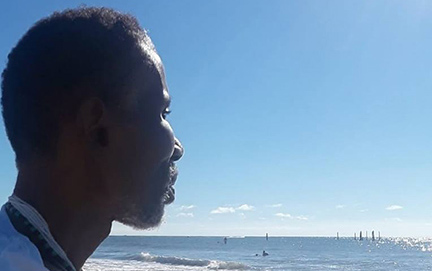Community News
Fulton St. Sculpture Deserves Closer Look: Todd Williams Broke Barriers!

This stainless-steel sculpture at Boys and Girls High was designed by a pioneering African-American School of Visual Arts graduate who exhibited at the Whitney Museum.
Credit: US Dept. of State Archives
Angela Davis, Amiri Baraka, Mark Twain and Victor Hugo have spoken through the ages: the built environment we erect around us reflects our values and civic priorities!
By: Morgan Sankofa Powell
Consider Boys and Girls High School an art museum. Its upcoming Fortieth Anniversary will mark the installation of 70s masterworks both outdoors and in. Three freestanding sculptures – visible from the public sidewalk along Fulton Street–animate the school’s entry plaza. Here, you see two dominant themes from that era: the Black Arts Movement and Abstraction. Commanding the corner like a cookie cut in sections is “Untitled” by Todd Williams.
Sharing this tree-lined plaza stands “Air Afrique # 4”, composed of two bent rectangles by Chris Shelton. Closest to the main entrance is the clear meaning of Ed Wilson’s “Middle Passage.” This last work in metal and concrete offers a descriptive plaque. To walk this open-air gallery is to witness a decade of turbulence and triumph. How did these monuments get here?
Bed-Stuy’s own Ernest Crichlow (1914-2005), a celebrated painter, revealed all in a Hatch-Billops Collection interview from 1985. “I got involved…myself and Jacob Lawrence were the people involved with the community when they first decided [to locate the new Boys and Girls High] school there…” These icons of 20th century American art generated lists of African-American artists to engage. The architect, Marty Stein, was also designing the Lorraine Hansberry School near the Bronx Zoo. He contracted monumental outdoor sculpture by Todd Williams for both. Recollecting Bed-Stuy in the 70s, Stein related much later, “It was the middle of Black Power… (the) whole environment was permeated. There was the sense that Boys and Girls High School was part of the whole thing.” We learn this from Michele Cohen’s 2002 manuscript, “Art to Educate: A History of Public Art in the NYC Public Schools, 1890-1976.”
Todd Williams came to the Boys and Girls Commission at the zenith of his career. He broke barriers with his generation with a 1971 group show at the Whitney Museum of American Art. That prominent Manhattan art venue had scarcely focused on African-American artists, however, they could not hold back the winds of change. Top-notch Black artists were as organized as they were vocal—American art included them and they demanded to be shown. They were in the streets, lecturing at libraries and colleges, captured in journals and knocking on gallery doors. The Whitney’s “Contemporary Black Artists in America” group show was a watershed moment in the national arts scene. Those heady days also saw the U.S. State Department make Williams a cultural ambassador; the New York Times had mentioned him more than once. Dakar, Mexico City and Singapore have been stamped on this formerly Brooklyn-based sculptor’s passport. Who’s Who in American Art listed his mailing address as 310 Atlantic Avenue (11201) in 1989.
Born to the Jim Crow misfortunes of Georgia (Savannah,1939), this lesser-known American post-modernist is collected from the Smithsonian Institute and Nelson Rockefeller Collection to corporate trusts like Pfizer and the National Insurance Co.. Over four decades, he’s exhibited in Michigan, New Jersey, Wisconsin, Iowa, Florida, North Carolina, California and leafy upstate cities like Ithaca and Elmira. Would you like to find his other public jewels here in our town? Prepare to cross Brooklyn and the East River.
J ust off Myrtle Avenue at 480 Knickerbocker is a gleaming silver panel composed of geometrics appearing to move. Along with a large rectangular field of like color it’s faceted to, this massive masterwork (circa 1983) commands the corner at Bleecker Street. Look closely at the lower right end of this work to see Williams’ name welded in steel. Also in the County of Kings, the community of I.S. 390 in Crown Heights enjoys a work (from 1984) that’s visible by appointment only. Ten smooth-touching panels, each uniquely shaped and sized, greet anyone using the original main entrance at Park Place and Troy Avenue. Nine feet tall from floor to ceiling, thirty-four wide feet of vivid color define this earlier portal (a side door now functions as the primary building entrance/exit). Next stop, historic Harlem!
Minisink Townhouse for teens stands a few yards from a sculptural group at the corner of Malcolm X Boulevard and 143rd Street. There, Williams’ work most resembles objects from everyday life, like his “Lollipops” sculpture even further uptown. Here, his “Ligion” (circa 1970) resembles a giant jigsaw puzzle at the scale of living room furniture. Just like Bed-Stuy, he’s shown with contemporaries: this time they are Melvin Edwards and Daniel Larue Johnson.
Still showing and growing in Maryland retirement, he continues to paint and make sculpture, represented by Peg Alston Gallery of Central Park West.
Of note: Lowery Stokes Sims, former director of the Studio Museum in Harlem wrote A Personal Recollection of the Black Art Scene of the 1970’s in their 2006 catalogue: Black Artists and Abstraction 1964-1980. Her words may help explain Boys and Girls art commissions: “In the context of the Civil Rights (and by then Black Power) Movement, many in the black community felt that the stakes were too high to leave the matter of art to chance. When the [Metropolitan Museum of Art] organized a symposium to discuss the situation of black arts in America…, the participants were, for the most part, abstractionists, including Sam Gilliam, Tom Lloyd, William T. Williams and Hale Woodruff, or abstract figural painters such as Romare Bearden and Jacob Lawrence. They had to discuss not only the role of the black artist in the community, but also what kind of art was appropriate for black artists to make. It led to many articles on the nature of the art made by black people, but it was often missed that one of the sources of modernist abstraction was African art, so abstraction could – more than realism – constitute the quintessential black art.”
Morgan Powell is a horticulturist and landscape designer. He began writing for OTP in October and also blogs for Outdoor Afro. He was first inspired to write this essay by Blake T. Kimbrough and Melvin A. Marshall at the opening night of “From Challenge to Triumph: African-American Prints & Printmaking 1867-2002.” They curated that show at the Museum of Contemporary African Diasporan Art (MoCADA), then located within Bridge Street Development Corporation.








